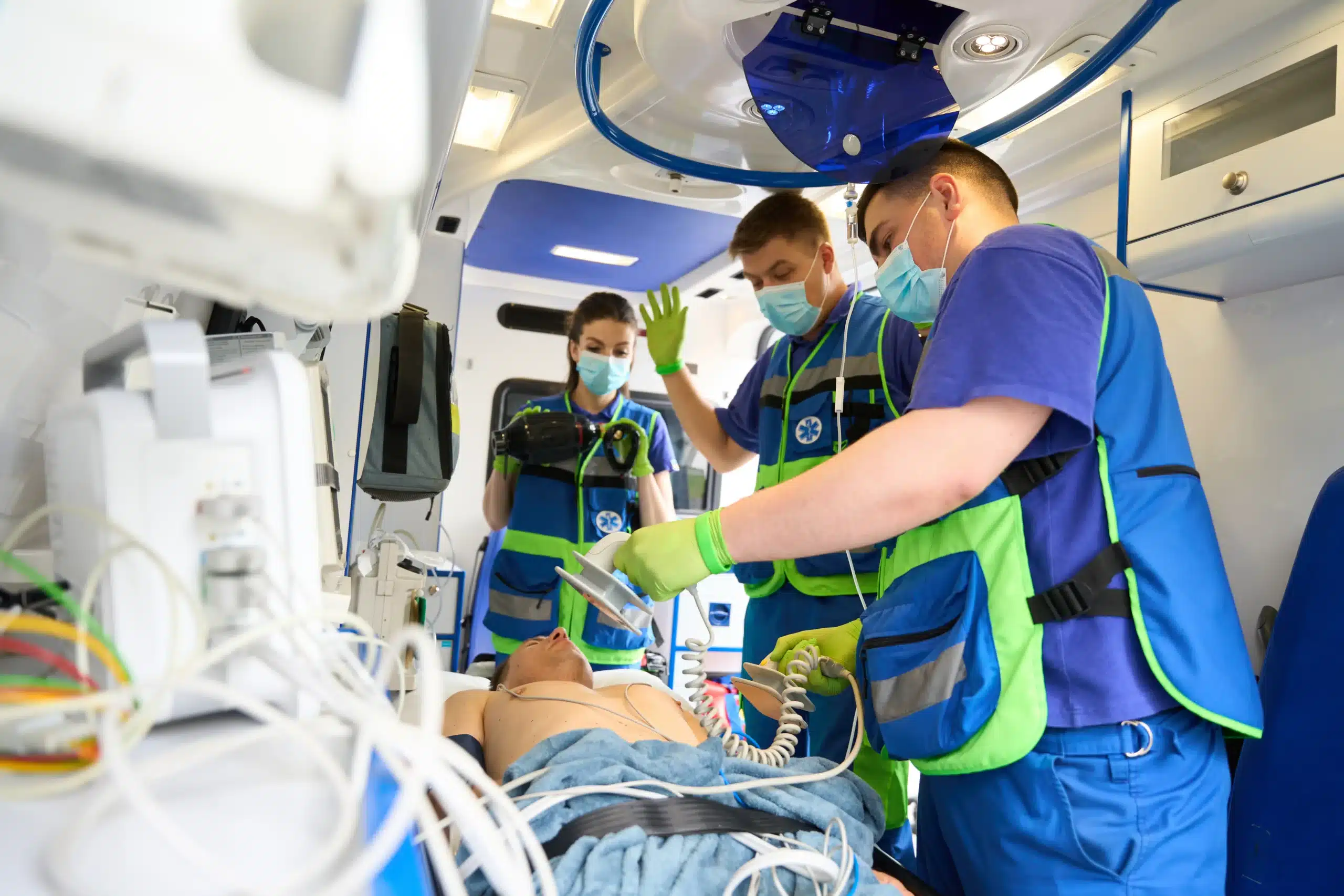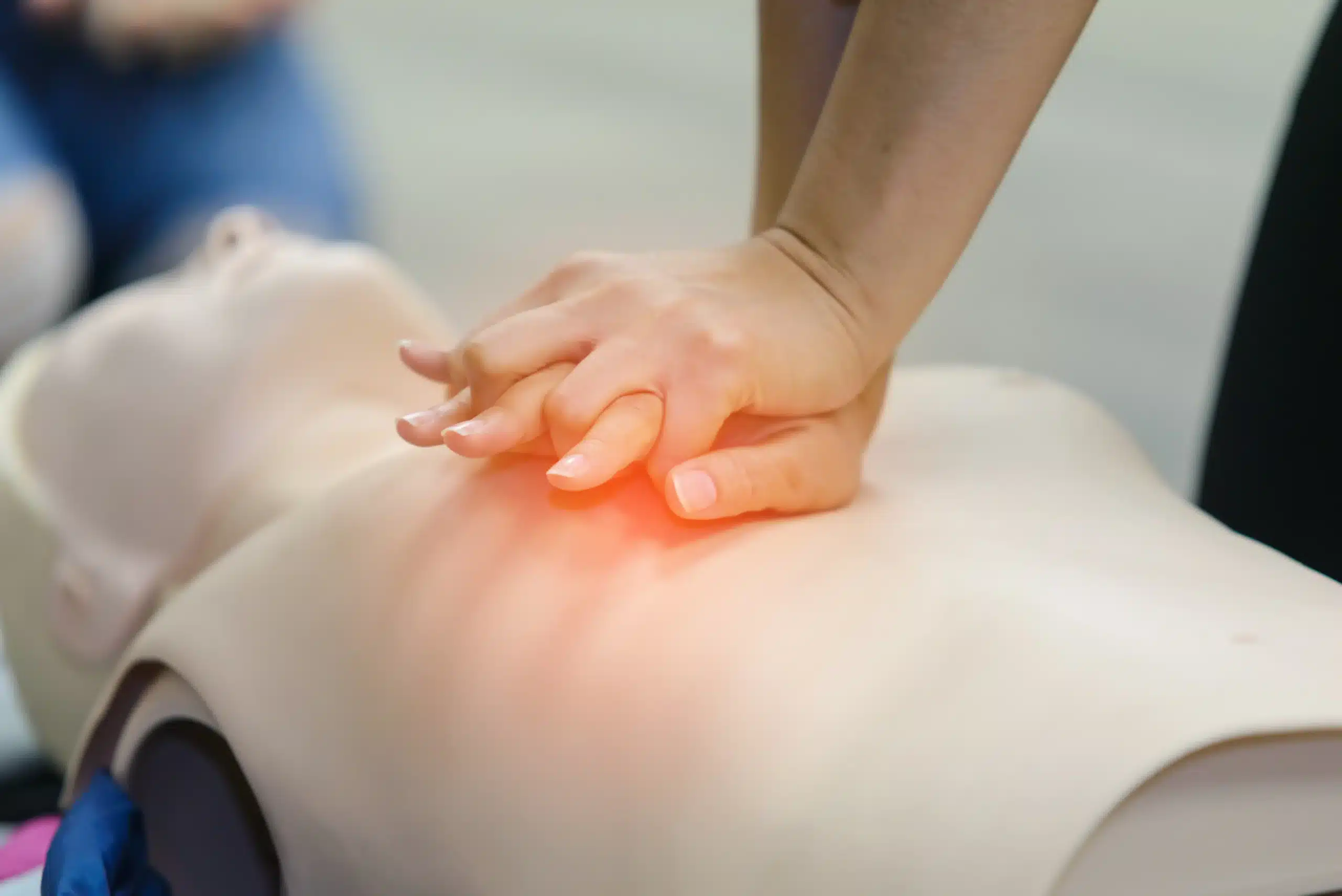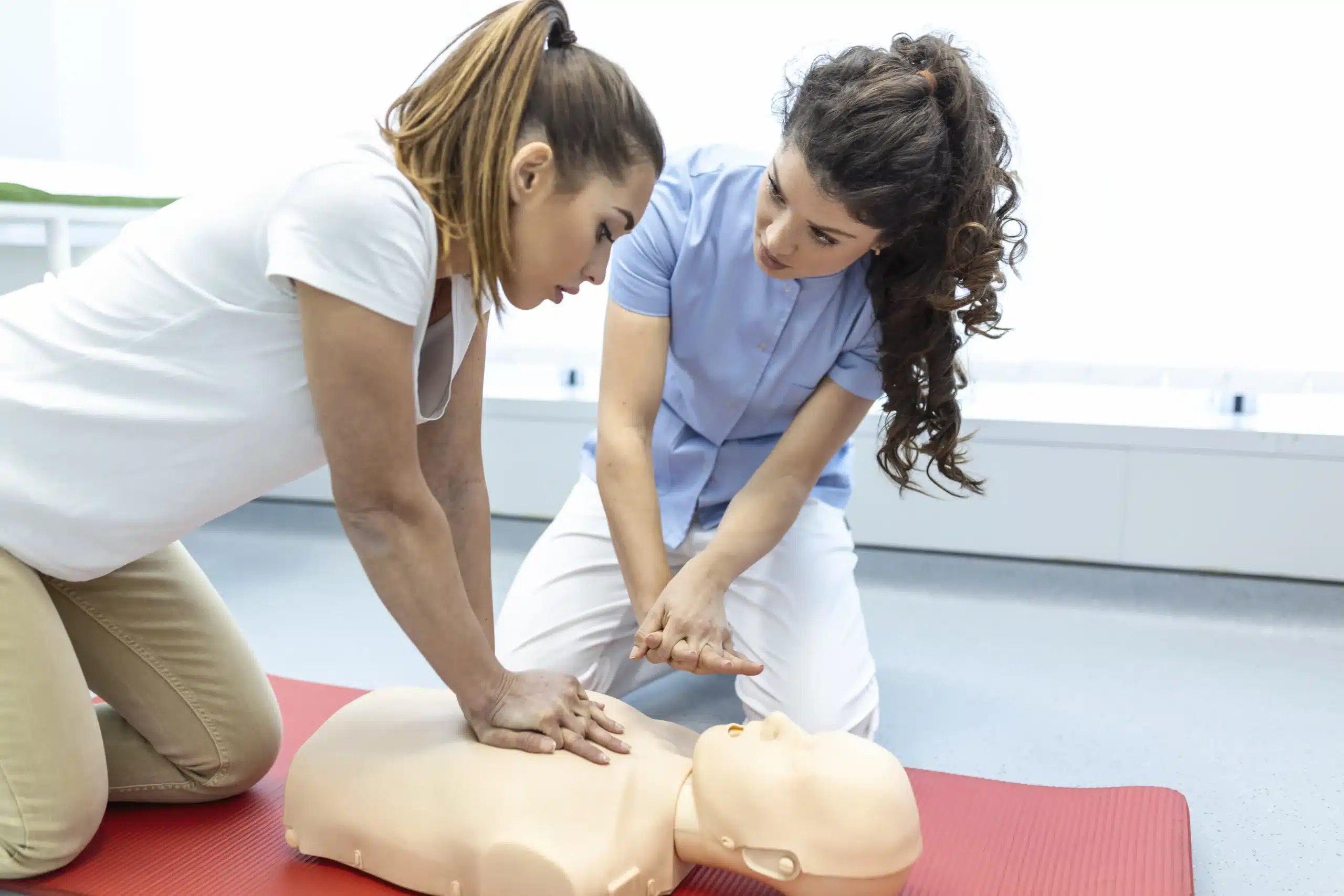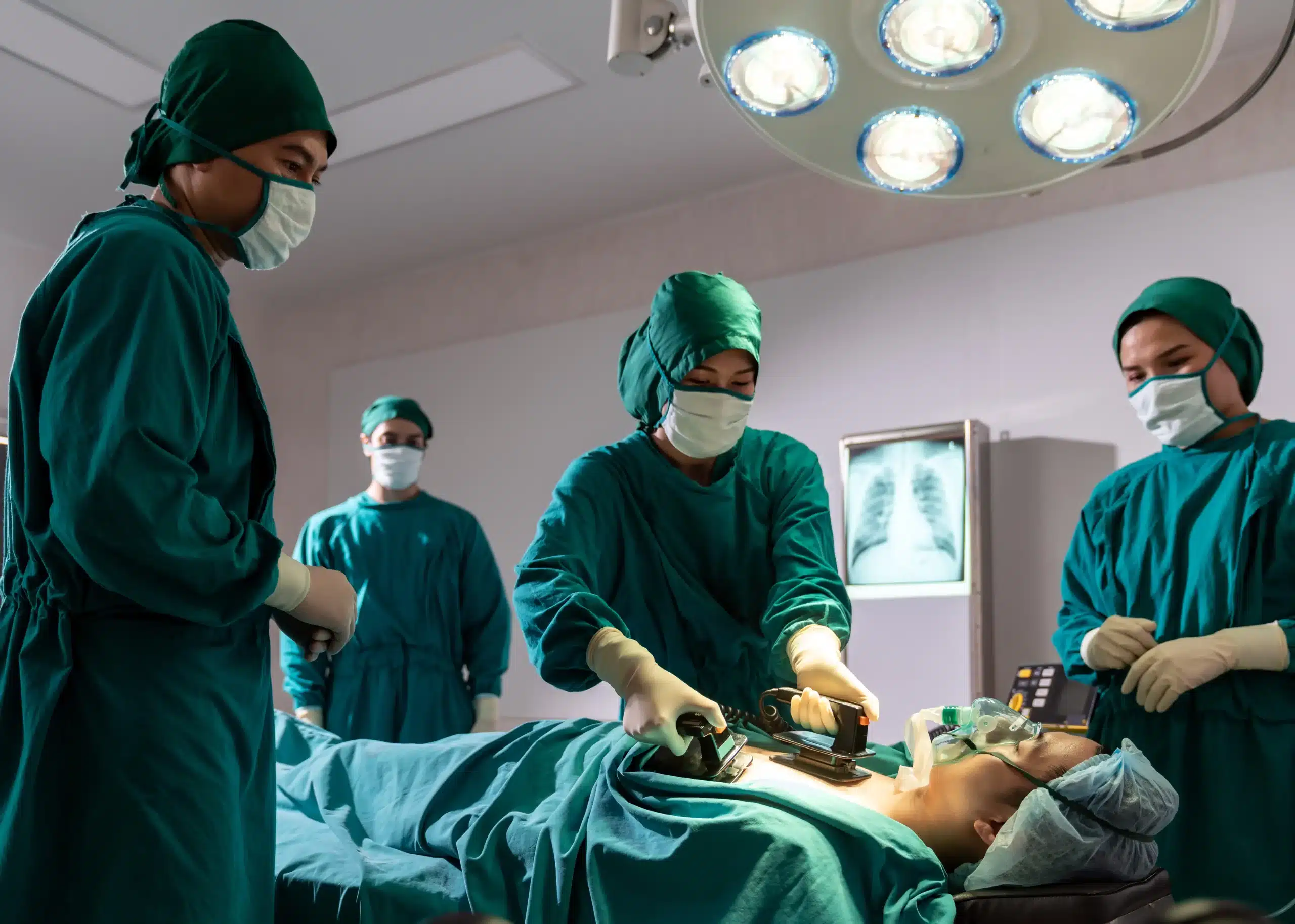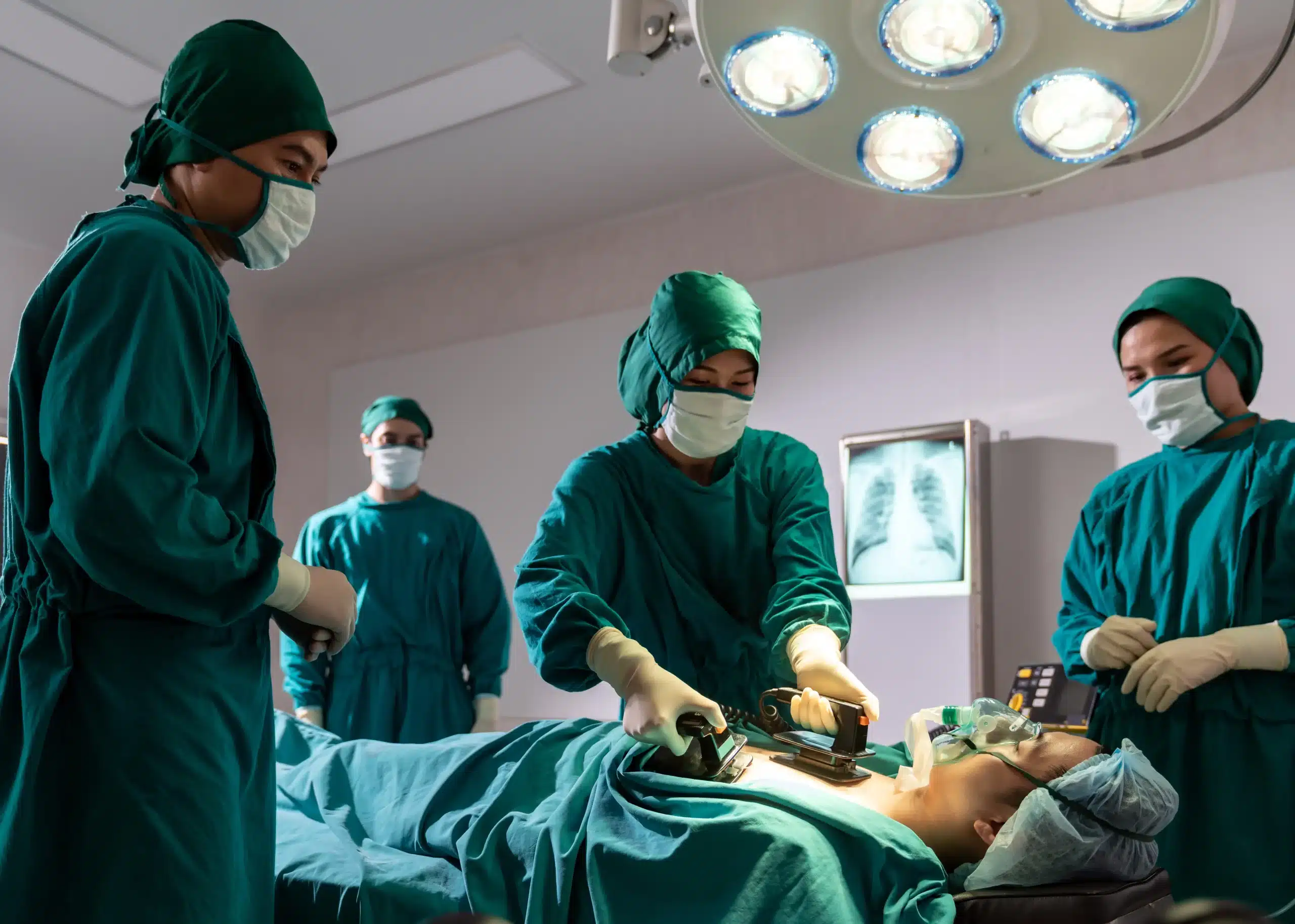Ready to take the leap and learn life-saving skills? BLS training courses in San Rafael offer a practical and empowering way to prepare yourself for medical emergencies. This comprehensive guide will walk you through everything you need to know about BLS certification, from debunking common myths to exploring the benefits for various careers. We’ll also provide valuable tips on preparing for your training and finding the right course in San Rafael. Whether you’re a healthcare provider, educator, or simply a concerned citizen, this guide will equip you with the knowledge and resources to get started on your BLS journey.
Key Takeaways
- BLS certification empowers anyone to save a life: These essential skills, including CPR, AED use, and airway management, are valuable for everyone, not just medical professionals. Equipping yourself with BLS training means you’re prepared to confidently handle a medical crisis, no matter where you are.
- Finding the right BLS course is straightforward: Consider factors like accreditation, schedule flexibility, hands-on practice opportunities, and reviews from other students. Providers like San Rafael CPR Classes offer AHA-compliant training in a comfortable learning environment.
- BLS certification offers lasting value: This credential enhances your resume and provides the confidence to respond effectively in emergencies. Knowing you can potentially save a life is an invaluable asset, both personally and professionally.
What is BLS Training?
Basic Life Support (BLS) training equips you with the skills to respond to life-threatening emergencies. It goes beyond basic CPR to include a broader range of techniques for cardiac arrest, obstructed airways, and other medical crises. BLS certification is a recognized credential, demonstrating your readiness to assist in critical situations. Many misconceptions exist about BLS training, so it’s important to understand its true scope and value. For example, some believe it’s only for healthcare professionals, but anyone can benefit from these life-saving skills. Our BLS course page has more information about our program.
Key BLS Skills
BLS certification covers core skills like high-quality CPR for adults, children, and infants. You’ll learn to use an automated external defibrillator (AED), a portable device that can restore a normal heart rhythm. The training also includes techniques for basic airway management and how to help someone who is choking. These skills are essential for responding effectively in emergencies.
Who Needs BLS Certification?
While BLS certification is vital for healthcare providers and medical professionals, it’s valuable for anyone who wants to be prepared for a medical emergency. Teachers, childcare providers, coaches, and even parents can benefit from BLS training. It empowers you to act quickly and confidently in situations where seconds can make a difference. See how affordable BLS training can be by checking our low price guarantee. If you work with children, you might also be interested in our EMSA Child Care Health & Safety course. For other CPR training resources in Northern California, visit our directory. Medical professionals can explore our RQI classes for a fast and efficient way to get certified.
Find BLS Training in San Rafael
Finding the right BLS training program means understanding your needs and researching local providers. Here are a few options to explore in San Rafael:
San Rafael CPR Classes
San Rafael CPR Classes offers American Heart Association-certified courses in CPR, BLS, ACLS, PALS, and First Aid. They’re conveniently located in San Rafael and serve surrounding communities like Corte Madera and Fairfax. With a low-price guarantee and classes running daily from 8 am to 10 pm, they offer flexible scheduling. Check out their RQI program for a streamlined certification process for healthcare professionals. Their comprehensive Northern California CPR directory is also a helpful resource.
American Heart Association Courses
The American Heart Association uses a blended learning approach to BLS training. Their BLS course combines online learning (1–2 hours) with hands-on skills testing (40–60 minutes) at a testing center. This format offers flexibility while ensuring you get practical training. Classes are available seven days a week, from 7 am to 6 pm.
Red Cross Programs
While the Red Cross doesn’t have a training center in San Rafael, many local providers offer Red Cross-certified BLS courses. These programs are known for their thorough approach to life-saving techniques. Check with training centers in your area to see if they offer Red Cross-certified BLS training.
Other Local Training Centers
Beyond dedicated CPR training centers, you can often find BLS courses through community organizations or hospitals. Safety Training Seminars is a reputable provider in the area, offering various course options. Broadening your search can help you find a course that fits your schedule and budget. Contact different providers to compare what they offer and find the best fit.
BLS Course Costs & Value
Getting BLS certified is an investment in your skills and ability to help others during emergencies. Let’s break down the typical costs associated with BLS training in San Rafael and explore the long-term value it offers.
Typical Course Prices
The average cost of a BLS course in San Rafael hovers around $120. This usually covers everything you need: the online portion of the course, the in-person skills test, and your American Heart Association (AHA) BLS certification card, which you’ll receive the same day you complete the course. This all-inclusive pricing makes it easy to budget for your training. San Rafael CPR classes offers a low price guarantee.
Extra Fees & Materials
You won’t typically encounter hidden fees with BLS courses. The quoted price generally includes the core components: CPR training for adults, children, and infants, instruction on using an Automated External Defibrillator (AED), and techniques for helping someone who is choking. This transparent pricing structure ensures there are no surprises along the way.
Discounts & Packages
Looking to train a group? Many providers in the San Rafael area offer discounts for group registrations. This can be a cost-effective solution for businesses, community groups, or even a group of friends who want to learn together. Check with local CPR training centers for more information on group discounts and package deals. For larger groups, San Rafael CPR Classes may be able to create a custom training package.
Long-Term Certification Value
Your BLS certification isn’t just a piece of paper—it’s a valuable credential recognized worldwide. Valid for two years, your AHA BLS certification demonstrates your commitment to providing high-quality care in emergency situations. It enhances your resume, provides peace of mind, and empowers you to confidently respond to medical emergencies. The value of knowing how to potentially save a life far outweighs the initial cost of the course. Plus, maintaining your BLS certification can open doors to career advancement in many fields.
Get BLS Certified
Getting your BLS certification is straightforward and often faster than people expect. Here’s what to expect:
Course Structure & Length
BLS courses typically involve a blended learning approach. You’ll start with online learning, which takes about one to two hours. This online portion covers essential theory and knowledge. After completing the online modules, you’ll schedule a hands-on skills test, which takes roughly 40 to 60 minutes at a designated testing center. Once you pass both, you’ll receive your certification.
Skills Tests & Evaluation
The skills test portion of BLS certification focuses on practical application. You’ll perform the skills you learned online on a computerized mannequin. While an instructor won’t be in the room during your test, support is available if you need it. If you have questions or require assistance, you can call the office for help.
Certification Renewal
Your BLS certification is valid for two years. When it’s time to renew, you won’t need to retake the entire course. The renewal process typically involves a theory exam and a skills test to ensure your knowledge and abilities are still sharp. This streamlined process makes staying up-to-date with your BLS certification convenient and manageable.
What Happens in BLS Training?
This section covers what you can expect during a typical BLS training course. Understanding the hands-on components, equipment used, and instructor qualifications will help you feel prepared and confident going into your training.
Hands-On Practice
BLS training is far from a passive experience. You’ll actively participate in scenarios designed to simulate real-life emergencies. These scenarios help you develop muscle memory and critical thinking skills under pressure. Expect to practice essential techniques like CPR compressions, rescue breaths, using an automated external defibrillator (AED), and basic airway management for adults, children, and infants. You’ll also learn how to assist someone who is choking. This hands-on practice builds your confidence and competence in responding to various emergency situations.
Equipment Used
High-quality BLS training incorporates the tools and equipment you’d encounter in a real emergency. This includes mannequins of different ages (adult, child, and infant) for realistic CPR practice. You’ll also work with AED training devices to understand how to operate these life-saving tools. Bag-valve masks, which are used to provide assisted ventilation, are another key piece of equipment you’ll become familiar with. San Rafael CPR Classes ensures you get experience with all the essential equipment, preparing you for real-world scenarios. The course typically involves a combination of online learning and hands-on skills testing, culminating in your certification.
Instructor Qualifications
Your instructor’s expertise plays a vital role in your BLS training. Look for certified instructors with extensive experience in the field. Qualified instructors can effectively demonstrate techniques, answer your questions thoroughly, and provide constructive feedback. A-B-CPR, for example, employs AHA-certified professionals. This ensures you receive training that meets the highest standards and prepares you to confidently respond to emergencies. Instructors should also be adept at creating a supportive learning environment where you feel comfortable asking questions and practicing your skills.
Choose the Right BLS Provider
Finding the right BLS training provider is crucial for a valuable learning experience. Consider these key factors when making your decision:
Accreditation & Standards
Ensure your chosen provider adheres to nationally recognized standards like those set by the American Heart Association (AHA). San Rafael CPR Classes offers AHA-compliant BLS training, ensuring you receive high-quality instruction and a recognized certification. A common misconception is that BLS certification is only for healthcare professionals. The truth is, while essential for medical personnel, BLS training benefits anyone who wants to be prepared for a medical emergency. Look for a provider that welcomes students from all backgrounds. Hayward CPR classes dispel some common myths about BLS training and who it’s for.
Facility & Equipment Quality
Hands-on practice is a cornerstone of effective BLS training. Choose a provider with a well-equipped facility. Your training should include practice with essential equipment like automated external defibrillators (AEDs), airway management tools, and other resources you’d encounter in a real-life emergency. High-quality BLS courses incorporate these elements to build your confidence and competence.
Reviews & Testimonials
Reading reviews and testimonials from past students offers valuable insights into a training provider’s strengths and weaknesses. Look for feedback on the quality of instruction, the facility, and the overall learning experience. Positive reviews can affirm you’re making a good choice, giving you confidence in your selected provider. San Mateo CPR Courses discusses the importance of BLS training for various healthcare providers.
Prepare for BLS Training
Getting ready for your BLS training doesn’t require weeks of intense study, but a little prep work can make your experience smoother and more productive. Here’s how to prepare:
Pre-Course Study
One of the best ways to set yourself up for success is to familiarize yourself with the core concepts before class. While BLS training is designed to be accessible to everyone—not just healthcare professionals—a basic understanding of CPR, AED use, and airway management can give you a head start. Check out resources like the American Heart Association BLS page for helpful overviews and study materials. You’ll learn about essential skills like how to recognize the signs of a cardiac arrest and perform high-quality chest compressions. Many courses, including those offered at San Rafael CPR Classes, also cover basic airway management and techniques for assisting someone who is choking.
What to Bring
Keep it simple. A notebook and pen are helpful for jotting down notes, though most courses provide key takeaways in printed or digital format. Dress comfortably. You’ll be practicing skills that involve movement and kneeling on the floor. Water is always a good idea to stay hydrated, especially during hands-on training sessions.
Physical & Mental Prep
BLS training involves physical activity, primarily chest compressions, which can be tiring. While you don’t need to be a marathon runner, being reasonably fit will make the physical demands of the training easier. Mentally preparing yourself is just as important. Remember that BLS certification isn’t a one-and-done deal; recertification is required periodically to stay up-to-date with the latest guidelines. Approach the training with a positive attitude and a willingness to learn these life-saving skills. Knowing you’re learning skills that could save someone’s life can help you focus and get the most out of your training. RQI classes offer a flexible recertification option for busy professionals.
BLS Benefits for Different Careers
BLS certification offers advantages across various professions. Whether you’re a healthcare provider, educator, or simply someone who wants to be prepared, understanding the benefits of BLS can help you see its value.
Healthcare Professionals
For healthcare professionals, BLS certification is essential. It equips you with the skills to respond effectively during emergencies, covering techniques like high-quality CPR, AED use, and airway management. These skills are fundamental to patient care and can significantly impact outcomes in critical situations. Beyond the technical skills, BLS certification demonstrates a commitment to patient safety and professionalism, enhancing your credibility within the medical community. It’s often a prerequisite for employment and career advancement in many healthcare settings. For more insights into the importance of BLS certification, check out the American Health Training Association.
Childcare Providers & Educators
BLS certification is incredibly valuable for childcare providers and educators. You’re entrusted with the safety and well-being of children, and BLS training provides the tools to respond effectively to medical emergencies. From choking incidents to sudden cardiac events, BLS training covers essential life-saving techniques like CPR, AED use, and basic airway management. Medtigo highlights how vital these skills are for anyone responsible for children’s safety. Having BLS certification offers peace of mind for parents and demonstrates your commitment to maintaining a safe and prepared environment.
Workplace Safety
BLS training isn’t just for healthcare settings; it’s a valuable asset in any workplace. Having employees trained in BLS enhances overall workplace safety and ensures a swift response to medical crises. This preparedness can be crucial in minimizing the impact of emergencies and potentially saving lives. Employers benefit from a more prepared workforce, and employees gain confidence in their ability to handle unexpected situations. BLS training fosters a culture of safety and preparedness, creating a more secure environment for everyone.
General Public & Caregivers
BLS certification isn’t limited to specific professions; it’s beneficial for anyone who wants to be prepared for a medical emergency. Whether you’re a caregiver for a family member, a concerned citizen, or simply someone who wants to make a difference, BLS training empowers you to act confidently in emergencies. Knowing how to perform CPR, use an AED, and provide basic life support can make a profound difference in critical situations, giving you the confidence to respond effectively and potentially save a life. This article further discusses how BLS training benefits the general public.
Other Life-Saving Courses
Beyond BLS certification, consider exploring other essential courses to expand your life-saving abilities. These courses often build on BLS fundamentals and offer specialized training for various demographics and emergencies.
Advanced Cardiac Life Support (ACLS)
Advanced Cardiac Life Support (ACLS) picks up where Basic Life Support (BLS) leaves off. It’s designed for healthcare professionals who regularly face cardiovascular emergencies. ACLS certification covers advanced interventions, complex algorithms, and effective teamwork in critical situations like cardiac arrest, stroke, and acute coronary syndromes. The training emphasizes a systematic approach to patient care, incorporating pharmacology and advanced airway management. If you’re a doctor, nurse, paramedic, or other healthcare provider, ACLS certification is often a job requirement and a valuable asset.
Pediatric Advanced Life Support (PALS)
Pediatric Advanced Life Support (PALS) focuses on the specific needs of infants and children during medical emergencies. This specialized training equips healthcare providers with the skills to recognize and respond to life-threatening situations in young patients. PALS courses cover pediatric-specific resuscitation techniques, airway management, and medication dosages. For anyone working in pediatrics, emergency medicine, or a related field, PALS certification demonstrates a commitment to providing excellent care for young patients.
First Aid & CPR Training
While BLS focuses specifically on life support, comprehensive First Aid and CPR training provides a broader skill set for handling various medical emergencies. These courses teach you how to respond to injuries like cuts, burns, and fractures, and how to manage sudden illnesses like allergic reactions and seizures. Combining First Aid and CPR training creates a well-rounded skill set to confidently address a wider range of emergencies, making you a valuable resource in any situation.
BLS Training Myths Debunked
Let’s clear up some common misconceptions about BLS training and certification. These myths can prevent people from getting the skills they need to save a life.
“Only for Healthcare Professionals”
One of the biggest myths is that BLS certification is only for doctors, nurses, and other healthcare providers. While it’s definitely essential for medical professionals, BLS training is valuable for anyone who wants to be prepared for a medical emergency. Think teachers, coaches, lifeguards, and even parents—anyone could benefit from knowing these skills. Learn more about who can benefit from our BLS certification courses.
“Too Time-Consuming”
Worried about a huge time commitment? Many BLS courses are designed to be efficient and can be completed in a single day. We understand you have a busy life, so we offer flexible scheduling options to make the process as convenient as possible. Our RQI program is a perfect example of how medical professionals can quickly renew their certifications.
“Not Necessary if CPR Certified”
Some people believe that basic CPR certification covers everything. While CPR training is a great foundation, BLS certification goes further. It covers more advanced techniques, team dynamics, and the use of equipment like bag-valve masks and AEDs. It’s a valuable addition to your skillset, even if you already know CPR. Explore our CPR and First Aid training for more comprehensive safety training options.
“Online Certification is Less Credible”
Online BLS certification has come a long way. Many reputable organizations, including the American Heart Association, offer online courses that meet the same rigorous standards as in-person training. These courses often combine online learning with in-person skills sessions, ensuring you get both the knowledge and practical experience you need.
“One-Time Requirement”
BLS certification isn’t a lifetime achievement. Like many certifications, it needs to be renewed regularly, typically every two years. This ensures you stay up-to-date on the latest guidelines and best practices, so you can provide the most effective care in an emergency. Take advantage of our low price guarantee to make staying current on your BLS certification affordable. We also have a directory of CPR resources in Northern California to help you find the right training.
Related Articles
- BLS Courses in Corte Madera: Your Certification Guide – San Rafael CPR Classes
- BLS Certification in Fairfax: The Complete Guide – San Rafael CPR Classes
- BLS Certification Near Me: Your Complete Guide – San Rafael CPR Classes
- BLS Classes in San Rafael: Your Guide – San Rafael CPR Classes
- Debunking CPR Myths for Lifesavers – San Rafael CPR Classes
Frequently Asked Questions
What’s the difference between CPR and BLS? CPR focuses solely on chest compressions and rescue breaths for someone not breathing or without a pulse. BLS encompasses CPR but also includes AED use, bag-valve mask ventilation, and other techniques for managing various medical emergencies, like choking. It often involves team dynamics and a more systematic approach to patient care.
How long does it take to get BLS certified? Many BLS courses use a blended learning format, combining online coursework with an in-person skills test. The online portion typically takes 1-2 hours, and the in-person skills test is usually around 40-60 minutes. You can often complete the entire process and receive your certification within a single day.
How much does BLS certification cost in San Rafael? BLS courses in San Rafael generally cost around $120. This usually covers the online learning materials, in-person skills test, and your certification card. Be sure to check with specific providers, like San Rafael CPR Classes, as they may offer discounts or a low-price guarantee.
How often do I need to renew my BLS certification? BLS certification is typically valid for two years. Renewal usually involves a shorter refresher course and skills test to ensure you’re up-to-date with the latest guidelines.
Is BLS training difficult? BLS courses are designed to be accessible to people of all backgrounds, not just medical professionals. While the skills are important and require proper training, the courses are structured to make learning manageable and effective. The hands-on practice and clear instruction help build confidence and competence.
